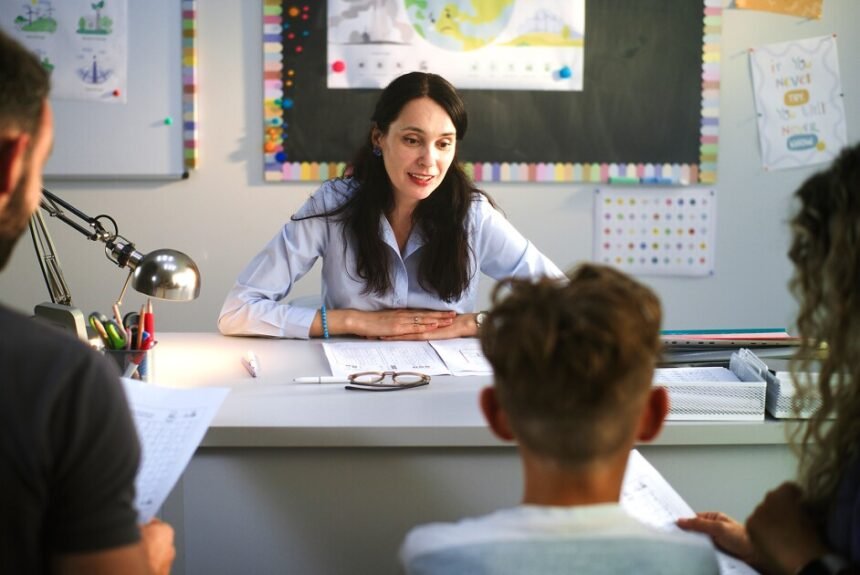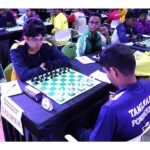It’s parent-teacher conference season. For everyone involved—teachers, students, and parents—these events frequently conjure up ambiguity, even dread.
Students may sit at home wondering and worrying what their teachers are saying about them. Teachers sometimes find themselves forced to defend the grades they give or even the curricula they deliver. Parents can feel unsure of what questions to ask or how to interpret teachers’ comments about their children. That is, if they choose to show up.
Attendance at traditional parent-teacher conferences has declined in recent years. In 2016, the most recent year that the National Center for Education Statistics published these statistics, an average of 91% of parents of elementary school students attended teacher-parent conferences, dropping to 73% by the time students hit middle school. When students reached high school, just 57% of parents attended these conferences.
Indicators suggest that these numbers have dropped further in recent years, especially post-pandemic. For instance, New York City in 2023 reported a 40% drop in attendance at parent-teacher conferences since before the pandemic.
But some schools have been able to buck this trend.
David Gundale, the principal of Open World Learning Community, a public magnet school in St. Paul, Minn., serving grades 6-12, says between 85% to 100% of parents routinely show up for twice-a-year conferences. What’s the secret? The parent-teacher conferences are led by the students.
“The participation level is over twice the amount of a traditional parent check-in with teachers,” said Gundale. “The big difference is that the [traditional] conferences are adult to adult versus the student at the center of things.”
Student-led conferences pack a lot of purpose into just a single 30-minute-or-so session. During these meetings, students often share the academic goals they’ve developed for themselves, showcase their work, and explain how they arrived at the final version of an assignment—one they’re proud of and possibly one they wish they had done differently. At end-of-year conferences, they also ponder out loud the growth they’ve made over the school year.
“It changes the relationship between the learner and the teacher and the learner and the parent, but it also requires the student to do some goal-setting, to do some reflection on their own progress, and to really demonstrate, through that conference, their thinking and learning process,” said Cheryl Jones-Walker, the director of the Center for School and System Redesign at the Learning Policy Institute. “It requires students to do some metacognition. And that becomes visible to the parent in this space and helps both the teacher and the parent really have a clear sense of where [students] are in their learning process.”
These conferences can meet several important learning goals, as Jones-Walker noted. But getting the most out of them requires intentional and thoughtful preparation.
Meaningful preparation is key for the success of student-led conferences
Preparation is a big part of the student-led conferences that take place at Open World Learning Community. It starts before the school year even begins.
The week before the first day of the new academic year, students and their parents meet with their crew leader (a faculty member who serves as an adviser) to come up with an academic, social, and personal goal for the year. This preparation means that students start school knowing what is expected of them—or, rather, what they expect of themselves.
Later in the fall, students lead the first of two school-year conferences. The school refers to the first one as HOWL, which stands for habits of work and learning. It provides students an opportunity to “check in” with the goals established during the pre-school-year conference and further prepares them for the conference that comes later in the year, where they’ll showcase to their parents the academic work they’ve completed over several months.
“We know that a student’s habits will set the tone for the full school year and lead into the mastery of skills and knowledge,” said Megan Hall, who teaches life science at Open World Learning.
At Friends School of Baltimore, a Quaker school serving students in P-12, educators believe it’s never too early for students to share the story of their learning journey. Students begin leading their own parent-teacher conferences in kindergarten.
Students start preparing their portfolio of work in the first month of school, adding to a growing binder that bulges by the spring when they sit down with their teacher and parents to share their work.
Jillien Ciresi, an assistant principal for grades P-1 at the school and a former 4th grade teacher there, said teachers make sure students’ work is dated and placed in the binder in chronological order, so they and their parents can see how much progress they made throughout the year.
But even before the portfolio building begins, teachers meet individually with students at the start of the year to set goals: social, emotional, and academic. Teachers share these goals with parents at a fall parent-teacher conference that students do not attend. Prior to the May student-led conferences, teachers revisit the goals with students.
“We see whether students think they’ve met them, and then we do a ton of reflection,” Ciresi said.
They also prepare for the student-led conference in practical ways. “We work on presentation skills: students’ volume, clarity of speech, eye contact, and body language,” said Ciresi, who explained that students pair up with a classmate to practice their presentation.
Students have the opportunity to showcase their work
The buildup to the spring presentations at Friends School makes the end of the year feel special for students and parents.
“I tell the students, ‘You’re sharing the story of your 4th grade year. So what do you think is going to best represent your story through the year?’” said Ciresi, who explained that students select a few assignments they’re proud of to share.
That same feeling of celebration pervades the end-of-year student-led conference at Open World Learning, particularly for 12th graders. That conference lasts an hour per graduating student, each of whom gets the opportunity to reflect on work throughout their time at the school.
“In many cases, it’s almost like a master’s dissertation. They’re not necessarily defending anything, but they’re sharing things,” Gundale said. “And they invite a large number of people. Sometimes, it’s 20 people in a room of friends that celebrate their work and their time. It’s a touching event.”
Unlike at many high schools, which struggle to get parents to attend conferences, parents of students at the Open World Learning Community get to feel like they’re joining a celebration, especially during the final event of their child’s high school experience. And students want their parents there.
“When a student has invested time to put together their presentation, they want their parents to come,” said Hall. “You can even see that in the hallway; they’re kind of dragging their parents toward the room, as if to say, ‘Pay attention to me. I did this work. I want to show you what I learned.’”







